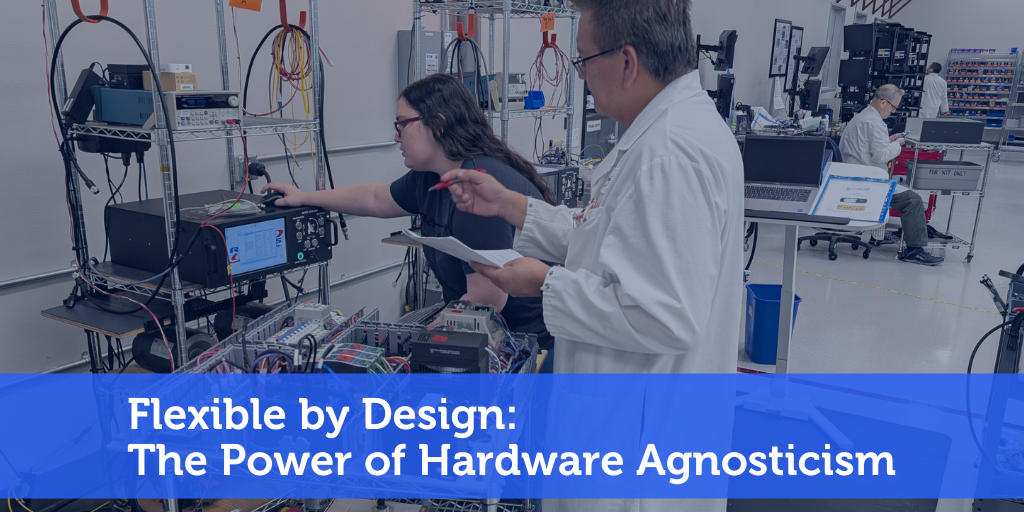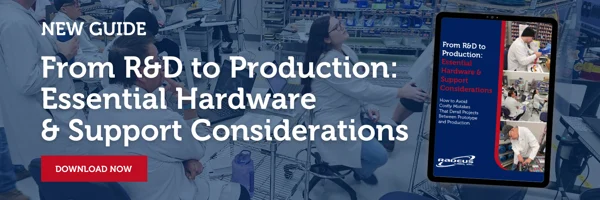With R&D and custom computing, the freedom to choose your components matters. But many organizations, knowingly or not, lock themselves into ecosystems that limit flexibility, drive up costs, and complicate integration.
That’s where hardware agnosticism comes in. For teams building prototypes, running AI workloads, or deploying complex edge computing systems, a hardware-agnostic approach isn't just a nice-to-have. It’s a strategic advantage that can mean the difference between project success and a painful, expensive rework.
Here’s what it really means to be hardware agnostic, and why it gives you an edge where off-the-shelf vendors fall short.
What “Hardware Agnostic” Actually Means
When a development team or solution provider is hardware agnostic, they aren't tied to a single brand, platform, or chipset. They can build systems around Intel, AMD, Windows, or Linux, depending on what fits the use case best.
Being hardware agnostic means:
- Designing systems based on requirements, not pre-defined partnerships
- Sourcing components from multiple vendors to optimize performance and longevity
- Avoiding single-vendor limitations, lock-ins, or pricing models
 At Radeus Labs, our engineers work this way by default. As one of our team members put it:
At Radeus Labs, our engineers work this way by default. As one of our team members put it:
“If a customer knows what they want, we don’t have an issue sourcing it for them. It’s about meeting their specs, not forcing them into ours.”
Where Off-the-Shelf Vendors Fall Short
Off-the-shelf systems are great, for standardized use cases. But in R&D or specialized applications, “standard” rarely applies. That’s where rigid vendor models hit a wall.
Here’s where off-the-shelf options often fall short:
- Limited configurability: Many commercial systems can’t be modified for specialized io, power needs, or form factors.
- Lack of support: Try getting a response from a global vendor when you’re not ordering at enterprise scale. Engineers in the field often find themselves waiting weeks for documentation, or never hearing back at all.
- Obsolescence risk: Major component manufacturers may discontinue products within 18–24 months, leaving you scrambling for substitutes midway through a project.
- Minimum order quantities: Early-stage R&D projects often require small quantities for testing. Off-the-shelf vendors don’t want to deal with “onesie or twosie” orders.
And worst of all, those limitations typically emerge after the project has started, when switching directions is costly and time-consuming.
The Benefits of Staying Vendor-Neutral
For teams working in AI, defense, satellite communications, and custom compute environments, the flexibility of a hardware-agnostic approach pays off in several key ways:
1. Flexibility to Solve Real Problems
When you’re not locked into a single vendor, you can combine parts that actually solve the problem at hand. Need a compact form factor, dual GPUs, and a custom bracket? You can do that, if your build isn’t constrained by one OEM’s design decisions.
2. Longer Product Lifecycles
Hardware-agnostic systems allow integrators to source longer-supported components or swap parts as they become obsolete, without redesigning the entire system.
One of our engineers notes it best:
“Some components are only manufactured for two or three years. Once they’re gone, they’re gone. If you’re tied to that one board, your whole product could be stuck.”
3. Better Fit for Field Conditions
Real-world environments introduce unique challenges, heat, dust, vibration, power fluctuations, that off-the-shelf systems aren’t always designed to handle. Custom systems can be built to withstand the realities of where your hardware actually operates.
4. Smarter Engineering Conversations
When engineers can choose the right tools for the job, they have more meaningful conversations, with customers and with other vendors. As our engineering team knows very well, working engineer-to-engineer across vendors allows for faster troubleshooting and better problem-solving.
Real-World Wins: How a Hardware-Agnostic Approach Solved Critical Challenges
These aren’t hypotheticals. Here are just a few examples of how our team’s vendor-neutral approach delivered practical results in the field:
- Third-Party Integration Without the Guesswork
When a customer brought in software from another vendor, the documentation didn’t match real-world behavior. Instead of getting stuck in support limbo, our engineers went straight to the source—speaking directly with the vendor’s technical team to resolve compatibility issues and keep the project moving. - Quick Resolution for a Critical Sensor Issue
A tilt sensor wasn’t being detected during system validation. Instead of waiting weeks for a support ticket to be escalated, our team contacted the component manufacturer directly, confirmed the failure path, and implemented a fix—no redesign, no downtime. - Smarter AI Builds with Multiple Configuration Paths
For an AI-based project with strict memory and compute needs, we sourced components based on actual performance requirements rather than brand loyalty. The result? Multiple configuration options tailored to different budget and performance tiers—without compromising delivery timelines.
Conclusion: Why It Pays to Build Without Limits
Hardware agnosticism isn't just a procurement choice, it’s an engineering philosophy. When you start with the freedom to design around the problem instead of the platform, you gain options, control, and the ability to adapt in a fast-moving world.
Especially in R&D, where requirements shift, components age quickly, and speed matters, having a partner who can support a vendor-neutral approach gives you a real edge.
Want to dig deeper into how flexible hardware strategies drive better R&D outcomes?
Download our new guide: From Hardware to Production: Essential Hardware & Support Considerations.
Inside, you’ll find practical insights on:
- Evaluating custom vs. commercial hardware
- Avoiding early mistakes that derail timelines
- Planning for long-term support and sourcing
[Get the guide now] and learn how to make hardware decisions that support your vision, without being limited by someone else’s product roadmap.





